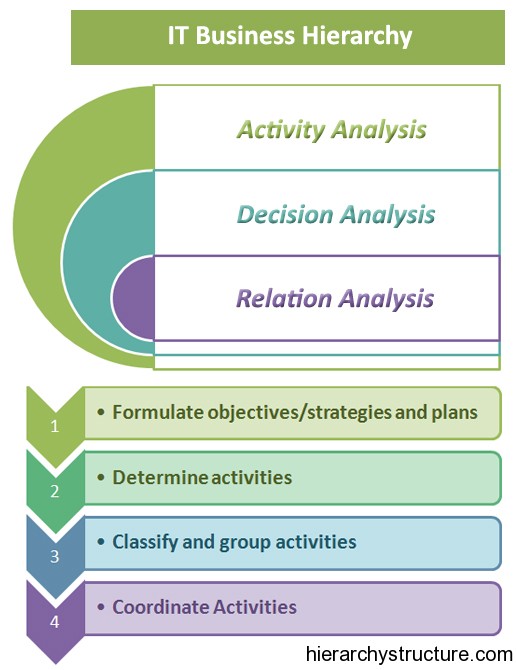The structure of an organization dealing with IT and ITES depends on the product that they develop. These organizations are majorly structures according to the technological disciplines. Generally such organizations observe a hierarchical arrangement where the responsibility for a particular project is never assigned to a single department.
In fact, all the departments and employees are organized in a hierarchical format and coordination is done through detailed specifications, shared traditions, rules and procedures, and distribution of work among engineers. With the help of such arrangement, job specifications become much more specialized and communication within the company becomes more formal.
In IT business hierarchy, not only employees and departments are organized in hierarchical manner, but Business strategy implementation also takes place in a hierarchical format, where there are pre-set steps to undertake any sort of project.
The top level is acquired by business strategies, which lead to plans, which in turn lead to programs to be undertaken, which would consist of projects, each with their own specifications & budgets. This all gets simplified at the operating level through policies, procedures, rules and regulations. From budget the flow starts in implementation, whose subsequent level is resource allocation.
Depending on all these factors, an n IT business hierarchy gets formulated. Following are the three major ways that can be used to finalize and determine the structure or hierarchy for an IT based business organization:

Activity Analysis
Activity analysis helps in determining the activities that need to be performed and what is the priority of each activity in the organizational objectives.
Decision Analysis
Decision analysis determines what kind of decisions is needed, where in the organization they should be made and how each manager should be involved in them. The answers to these questions also help in formulating a well-suited IT business hierarchy that works as per the organizations requirements and link every employee in the required format.
Relation Analysis
This includes finding out how the activities in the organization are interlinked and how these activities are linking various departments & in which order.
After considering all these factors, and hierarchical arrangement can be formed that will enhance the efforts made by the employees of the organization towards its growth and business development. After deeply understanding these factors, following steps are taken to develop a well-knit IT business hierarchy:
- Formulate objectives, strategies and plans.
- Determine activities needed to execute these plans and policies, and to accomplish the objectives.
- Classify and group the activities in the best possible way, by grouping jobs & people into sections & departments, and into higher administrative units.
- Coordinate and tie these groups of activities through authority relationship in the horizontal, vertical and lateral arrangement.
By the proper integration and coordination of related activities in the required sequence and at the required levels, we can get a proper hierarchy that leads to the unity of objectives, teamwork, team spirit and development of the organization as a whole.
